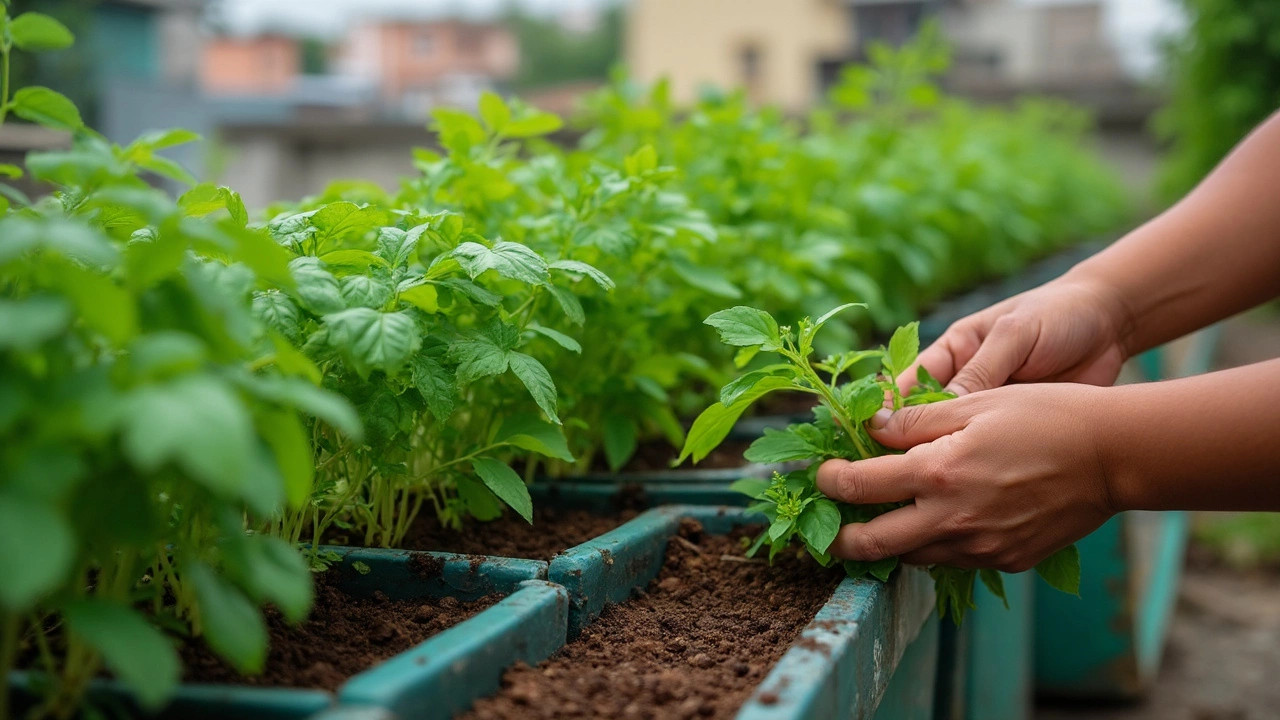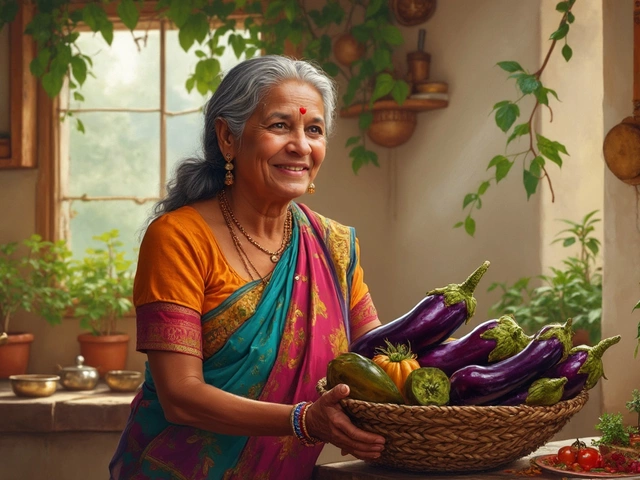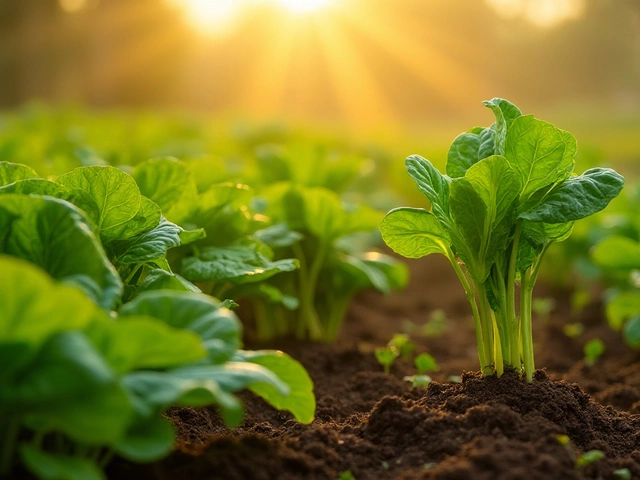Skip grocery lines and bring fresh veggies straight from your garden to your plate—it’s actually possible, even if all you’ve got is a balcony or a sunny window ledge. In India, loads of vegetables have adapted to our weather and can thrive at home if you know which ones to pick.
Tomatoes, green chillies, and coriander are some of the easiest winners to start with. Seeds for these are cheap, widely available, and they don’t need a ton of space. Even if you’re a complete gardening newbie, you’ll probably get results in just a few weeks. If you have a little more room, try growing okra (ladyfinger) or brinjal (eggplant)—both love the Indian climate and are forgiving if you forget to water for a day or two.
Want a super fast harvest? Radishes and spinach can be ready in under a month during the cooler season. Herbs like mint and curry leaves barely need looking after—just stick a stem in soil and water now and then. Fresh, homegrown veggies really do taste better, and you totally control what goes into them. Ready to see what else you can grow at home? Let’s dig into the best options for Indian households.
- Best Vegetables for Indian Homes
- Climate and Season Basics
- Smart Growing Tips for Urban Spaces
- Common Troubles and Quick Fixes
Best Vegetables for Indian Homes
Picking the right veggies for your home garden can make a big difference when you're starting out. Some types just grow better in our weather and work fine with the kind of space you probably have at home. Here’s what makes sense for most Indian homes, whether you have a terrace, a balcony, or a small plot out back.
Vegetable gardening in India is all about going for the tried-and-tested. Tomatoes top the list for a reason: they can grow in pots, and a single plant often gives you dozens of juicy fruit. Chillies and coriander fit right into small containers and pop up quickly after sowing. Beans (like French beans or cluster beans) are another no-fuss pick, and you can train the vines upwards to save space.
- Tomato: Needs a medium-sized pot. Likes sun and regular watering. You’ll spot flowers and little tomatoes in about 5 weeks.
- Coriander (Dhaniya): Grows fast, and keeps giving leaves if you snip instead of pulling the whole thing out.
- Green Chillies: Hardy in all seasons except very cold months. Harvest fresh chillies multiple times from each plant.
- Spinach (Palak): Can be cut and regrown. Quickest to harvest, you could be eating homegrown greens in 25-30 days.
- Fenugreek (Methi): Sows like coriander, easy to maintain, needs sunlight and a few waterings a week.
- Okra (Bhindi): Loves Indian heat and sun. Needs a deep pot but very little else. The plants keep giving for weeks.
- Radish (Mooli): Fast sprouter. Sow right into your main pot, and you can eat both the root and the green tops.
- Brinjal (Baingan): A good fit if you have a bit more space. It needs sun but isn’t very fussy otherwise.
Got just a windowsill? Try herbs like mint or curry leaves, which don't mind some shade and take up almost no space. For families with a bit more room, bottle gourd (lauki) or bitter gourd (karela) can be grown vertically with a simple trellis.
Here’s a handy cheat sheet to see what you can expect from these veggies at a glance:
| Vegetable | Sunlight Needed (hours/day) | Time to First Harvest | Recommended Pot Size |
|---|---|---|---|
| Tomato | 6-8 | 60-70 days | 12-16 inches |
| Coriander | 4-6 | 20-25 days | 6-8 inches |
| Green Chilli | 5-7 | 50-60 days | 8-10 inches |
| Spinach | 3-5 | 25-30 days | 6-8 inches |
| Okra | 6-8 | 45-50 days | 12-14 inches |
| Radish | 4-6 | 30-40 days | 8-10 inches (deep) |
| Brinjal | 6-8 | 70-80 days | 12-16 inches |
Here’s something fun: people in Indian cities are setting up simple vertical gardens using plastic bottles and old containers. Don’t get stuck thinking you need fancy pots or a lot of land. Look around your kitchen—anything with drainage can be a planter. And if you forget to water for a day or two, don’t panic; most Indian veggies bounce back easily!
Climate and Season Basics
You can't grow every veggie all year round—not in India, anyway. The heat, rain, and short winters make it important to choose your plants by season. Most folks get the vegetable gardening bug during cool months, but there's something you can grow basically anytime if you know what to pick.
India has three main growing seasons for veggies:
- Rabi (winter): October to March—great for carrots, spinach, peas, and radishes.
- Kharif (monsoon): June to September—ideal for beans, gourds, okra, and brinjal.
- Zaid (summer): March to June—try cucumbers, bitter gourd, and pumpkins.
The timing isn’t just tradition—temperature and rain actually make a huge difference. Carrots and spinach, for example, go bitter or bolt quickly if it gets too hot, while okra and chillies love basking in summer sun.
Here’s a handy table showing the best time for some popular home garden veggies in India:
| Vegetable | Best Season to Grow | Temperature Range (°C) |
|---|---|---|
| Tomato | Rabi & Kharif | 20-28 |
| Spinach | Rabi | 15-25 |
| Okra (Ladyfinger) | Kharif & Zaid | 25-35 |
| Coriander | Rabi & Zaid | 15-30 |
| Brinjal (Eggplant) | Kharif | 20-30 |
| Radish | Rabi | 10-25 |
Soil also reacts to the climate. During monsoons, you want good drainage so roots don’t rot. In winter, sunlight matters even more because days are short, and without enough direct sun, leafy greens just won’t grow bushy.
“Choosing your crops based on climate and season is half the battle won in kitchen gardening.” — Dr. R. K. Roy, Indian Institute of Vegetable Research
Got a small space? Don’t let the season stop you. Quick fix: Start seeds in little containers on a windowsill, then move them out when weather’s right. A cheap temperature gauge helps, but honestly, your phone’s weather app and a bit of local chat are enough to avoid major mistakes. The biggest secret: Even one season of trial-and-error tells you what works in your area better than the fanciest guidebook.

Smart Growing Tips for Urban Spaces
City living doesn’t mean you miss out on growing your own veggies. Most common vegetables don’t need a garden or huge yard. In fact, millions of people in cities like Mumbai and Bangalore use balconies or terraces as little farms. Here’s how you make the most of tight spaces:
- Pick the right containers: Buckets, grow bags, and even old plastic bottles work. Tomatoes and brinjal do well in deeper pots (at least 10-12 inches deep), while leafy greens like spinach or coriander grow fine in shallow trays.
- Light is everything: Six hours of sunlight is the sweet spot for most Indian veggies. Balconies facing east or south are usually best. If your place is shady, try leafy greens or pudina, since they tolerate less sun.
- Use good soil: Don’t just dig up dirt from outside (urban soil might have chemicals). Mix up store-bought potting mix, cocopeat, and a scoop of compost. Even old kitchen waste—banana peels or tea leaves—boosts nutrients when composted well.
- Water smart: In summer heat, potted veggies dry up fast. Always check the top inch of soil. If it’s dry, water it generously, but skip soggy soil. Early mornings work best for watering before the sun’s too strong.
- Space plants out: Overcrowding is tempting but it invites pests and stops growth. For instance, leave at least 6 inches between spinach plants or about 2 feet between brinjal saplings.
If you’re short on floor space, use vertical tricks. Hang pots on grill railings or upcycle shelves against a sunlit wall. Stackable planters and vertical grow bags quickly multiply your planting area without eating up valuable living space.
| Vegetable | Ideal Container Depth | Notes |
|---|---|---|
| Tomato | 12-15 inches | Needs staking as it grows |
| Chilli | 8-10 inches | Loves warmth and sun |
| Spinach | 6-8 inches | Shallow tray works |
| Coriander | 6-8 inches | Harvest leaves often |
| Brinjal | 12-15 inches | Space for roots is key |
Balcony gardening also gives you a leg up on pest control since you’ll spot bugs early. A simple soap-water spray can tackle aphids and whiteflies. Trying to grow vegetable gardening in India really comes down to making small spaces work for you—so grab those old containers lying around and put them to use. You’ll be surprised at how much you can harvest, even from a single sunny corner.
Common Troubles and Quick Fixes
No matter how careful you are, vegetable gardening in India comes with its own share of bumps. Don’t panic—almost every problem you hit is fixable with a quick tweak. Here’s how to deal with the usual suspects that pop up for home gardeners.
Vegetable gardening in Indian conditions often features these pain points:
- Yellowing leaves: Nine times out of ten, this means you’re either overwatering or underwatering. Stick your finger in the soil—if it’s soggy, skip watering for a day or two; if it’s dry, water more often.
- Slow or stunted growth: Your plants might be hungry for nutrients. Top up with homemade compost, or add a spoonful of cow dung slurry every two weeks. Even kitchen waste tea leaves work as a decent pick-me-up.
- Pests like aphids, mealybugs, or caterpillars: Don’t reach for chemical sprays first. Mix a teaspoon of liquid dish soap in a litre of water and spray it on your plants. Neem oil is another proven homemade solution – two sprays a week usually sends pests packing.
- Mildew and fungal spots: If you spot white powdery patches or black spots, water in the morning so the leaves dry by noon. Remove infected leaves right away and give your plants extra breathing room if they’re crowded.
Check out this quick stats table—these are the top three troubles for Indian kitchen gardens and their easiest fixes:
| Problem | Main Cause | Quick Fix |
|---|---|---|
| Yellow leaves | Water imbalance | Adjust watering routine |
| Pest attack | Aphids/mealybugs/caterpillars | Spray neem oil or mild soap solution |
| Stunted plants | Lack of nutrients | Add compost or liquid fertilizer |
Struggling with birds pecking tomatoes or squirrels digging up seeds? Try hanging old CDs or colourful bits of cloth near your plants—the moving reflections usually chase them off. Don’t be afraid to start small. The more you experiment, the quicker you’ll spot and fix problems before they wreck your efforts. And remember, even the best gardeners lose a few plants now and then. That’s just part of the fun.




